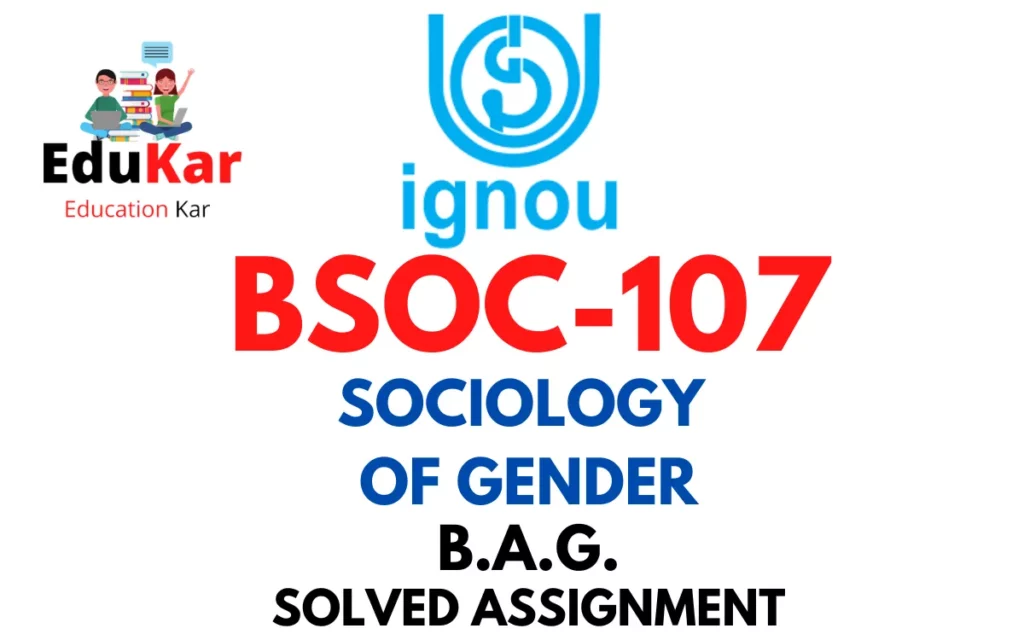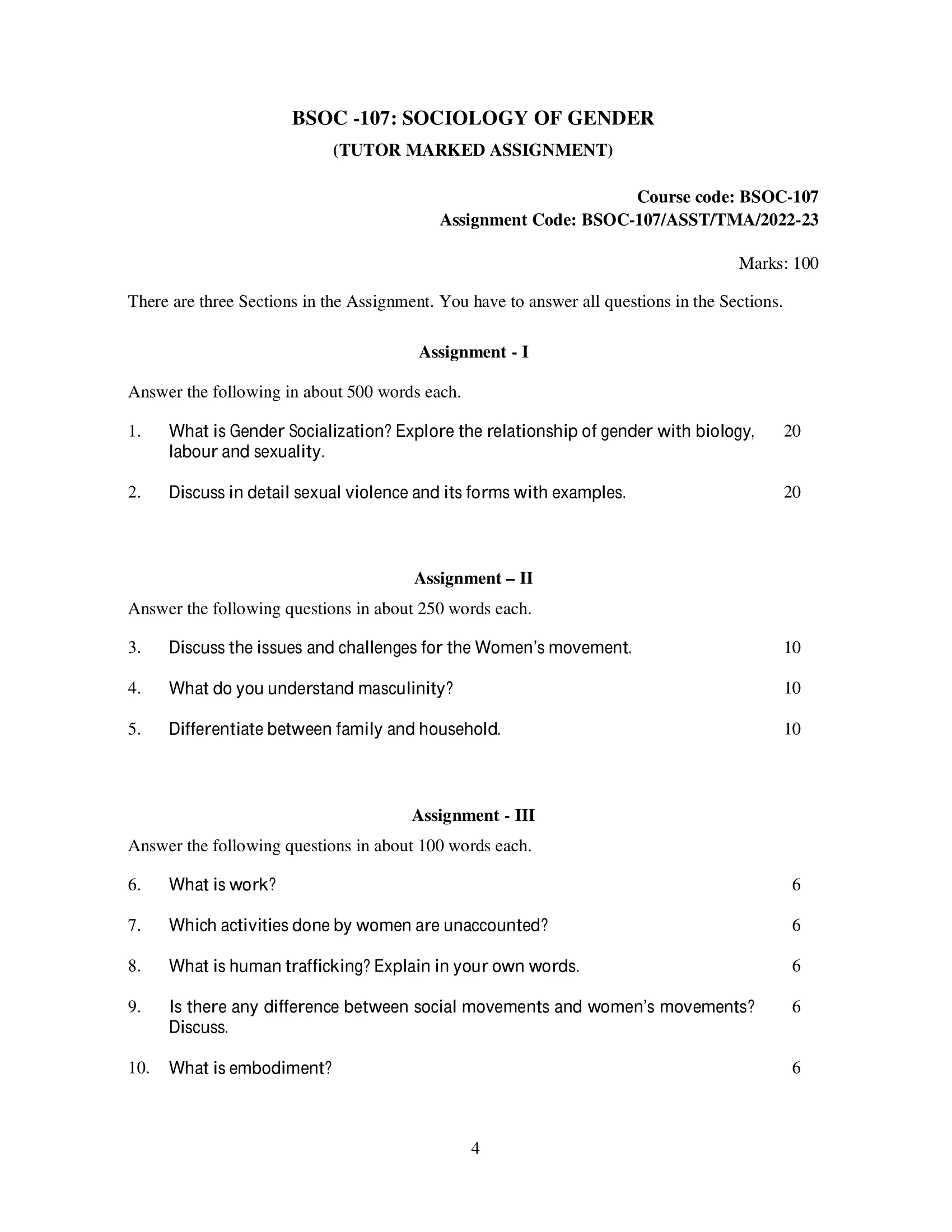Contents
- 1 Assignment – I
- 2 Answer the following in about 500 words each.
- 3 What is Gender Socialization? Explore the relationship of gender with biology, labour and sexuality.
- 4 Discuss in detail sexual violence and its forms with examples.
- 5 Assignment – II
- 6 Answer the following questions in about 250 words each.
- 7 Discuss the issues and challenges for the Women’s movement.
- 8 What do you understand masculinity?
- 9 Differentiate between family and household.
- 10 Assignment – III
- 11 Answer the following questions in about 100 words each.
- 12 What is work?
- 13 Which activities done by women are unaccounted?
- 14 What is human trafficking? Explain in your own words.
- 15 Is there any difference between social movements and women’s movements? Discuss.
- 16 What is embodiment?

| Title | BSOC-107: IGNOU BAG Solved Assignment 2022-2023 |
| University | IGNOU |
| Degree | Bachelor Degree Programme |
| Course Code | BSOC-107 |
| Course Name | SOCIOLOGY OF GENDER |
| Programme Name | Bachelor of Arts (General) |
| Programme Code | BAG |
| Total Marks | 100 |
| Year | 2022-2023 |
| Language | English |
| Assignment Code | BSOC-107/ASST/TMA/2022-2 |
| Assignment PDF | Click Here |
| Last Date for Submission of Assignment: | For June Examination: 31st April For December Examination: 30th September |

Assignment – I
Answer the following in about 500 words each.
What is Gender Socialization? Explore the relationship of gender with biology, labour and sexuality.
Ans: Gender socialization is the process by which individuals learn and internalize the social expectations and norms associated with their gender. It is the process through which individuals learn to behave in ways that are considered appropriate or typical for their gender. This process begins at a very young age and is ongoing throughout an individual’s life.
Gender socialization occurs through a variety of social institutions and agents, including families, schools, peers, media, and religious institutions. These agents communicate and reinforce gender roles, expectations, and norms through a variety of methods, including socialization messages, behaviors, and attitudes.
The Relationship of Gender with Biology
Biological sex is determined by a person’s reproductive anatomy, hormones, and chromosomes. There are typically two main biological sexes, male and female, and the majority of individuals are born with a sex that is consistent with their chromosomes and reproductive anatomy. However, there are some individuals who are born with intersex traits, which means their reproductive anatomy, hormones, and/or chromosomes do not fit typical definitions of male or female.
While biological sex is determined by one’s anatomy and chromosomes, gender is a social construct that refers to the social and cultural meanings that are attached to being male or female. Gender roles and expectations vary across cultures and can change over time. For example, in some cultures, it may be considered acceptable for men to cry and show emotion, while in other cultures, it may be seen as a sign of weakness.
The Relationship of Gender with Labor
Gender socialization also has an impact on the way that individuals are expected to participate in the workforce. Historically, men have been seen as the primary breadwinners, while women have been expected to prioritize caregiving and domestic responsibilities. These gender roles have been reinforced through socialization messages and expectations, as well as policies and practices within the workplace.
While women have made significant strides in the workforce in recent years, there is still a significant gender wage gap and a lack of representation of women in leadership positions. These inequalities are often attributed to gender bias, discrimination, and the persistence of traditional gender roles and expectations.
The Relationship of Gender with Sexuality
Gender socialization also plays a role in shaping individuals’ sexual attitudes and behaviors. For example, men are often socialized to be sexually assertive and dominant, while women are socialized to be more passive and submissive. These gendered expectations can influence how individuals communicate about sex, express their desires, and experience pleasure.
Gender also intersects with sexual orientation and identity. For example, individuals who identify as LGBTQ+ may face discrimination and stigma due to their gender identity or sexual orientation. This can lead to negative mental health outcomes, such as depression and anxiety.
Discuss in detail sexual violence and its forms with examples.
Ans: Sexual violence is a type of violence that involves any sexual act or behavior that is forced or coerced without the consent of the victim. It can take many forms, including but not limited to rape, sexual assault, sexual harassment, sexual exploitation, and sexual coercion. Sexual violence can have profound and long-lasting impacts on survivors, including physical, emotional, and psychological harm.
Forms of Sexual Violence
- Rape: Rape is a form of sexual violence that involves non-consensual penetration of the victim’s body. This can include vaginal, anal, or oral penetration, and can be committed by any gender. Rape can be violent and may involve physical force or the threat of force, or it can occur without the victim’s knowledge, such as when the victim is incapacitated by drugs or alcohol.
Example: A woman is walking alone at night when she is attacked and raped by a stranger.
- Sexual Assault: Sexual assault involves any unwanted sexual contact, including touching or groping. Sexual assault can be committed by anyone, and can occur in a variety of settings, including in public, at home, or in the workplace.
Example: A man touches a woman’s breast without her consent while they are on a crowded train.
- Sexual Harassment: Sexual harassment involves any unwanted sexual behavior that creates a hostile or intimidating environment. This can include unwanted sexual advances, comments, or gestures, as well as explicit sexual language or imagery. Sexual harassment can occur in any setting, including at school, in the workplace, or in public.
Example: A male boss makes unwanted sexual comments to a female employee, and threatens to fire her if she does not comply with his advances.
- Sexual Exploitation: Sexual exploitation involves the use of someone’s sexuality for personal gain or profit. This can include forcing someone into prostitution or pornography, or using their sexuality for blackmail or other forms of control.
Example: A pimp forces a young woman into prostitution, taking most of the money she earns and using physical violence to keep her under control.
- Sexual Coercion: Sexual coercion involves the use of pressure or manipulation to force someone into sexual activity. This can include using threats, emotional manipulation, or other forms of coercion to gain sexual access to someone.
Example: A man tells his girlfriend that he will leave her if she does not have sex with him, even though she does not want to.
Impacts of Sexual Violence
The impacts of sexual violence can be severe and long-lasting. Survivors of sexual violence may experience physical harm, including injuries sustained during the assault or exposure to sexually transmitted infections. They may also experience emotional and psychological harm, including anxiety, depression, and post-traumatic stress disorder (PTSD).
Sexual violence can also have a profound impact on survivors’ relationships, work, and daily life. Survivors may experience shame, self-blame, and a sense of isolation, and may struggle to form healthy relationships or maintain their employment.
Assignment – II
Answer the following questions in about 250 words each.
Discuss the issues and challenges for the Women’s movement.
Ans: The women’s movement has made significant progress over the years, but there are still issues and challenges that women face, which continue to hinder gender equality. Some of these challenges include:
- Gender-based violence: Violence against women is still a pervasive issue globally, with women experiencing physical, sexual, and emotional abuse in their homes, workplaces, and communities. The women’s movement is working towards creating a safe and equal society that is free from violence.
- Gender pay gap: Despite laws that prohibit discrimination based on gender, women still earn less than men for the same work. The women’s movement is advocating for equal pay for equal work, as well as addressing other factors that contribute to the pay gap, such as occupational segregation and the lack of flexible working arrangements.
- Lack of representation in leadership positions: Women continue to be underrepresented in leadership positions, whether in politics, business, or other sectors. The women’s movement is working towards creating a society where women have an equal opportunity to participate and lead.
- Lack of access to education and healthcare: Women in many parts of the world still face barriers to accessing education and healthcare. The women’s movement is working towards breaking down these barriers to ensure that women can access the same opportunities as men.
- Intersectionality: Women’s experiences are not the same, and there are specific challenges that women from different races, classes, sexualities, abilities, and religions face. The women’s movement is working towards creating an inclusive movement that recognizes and addresses the intersectional nature of gender inequality.
What do you understand masculinity?
Ans: Masculinity is a complex concept that refers to the traits, behaviors, and attitudes that are traditionally associated with men and masculinity. It encompasses a wide range of characteristics, including physical strength, emotional toughness, assertiveness, and self-reliance, among others.
However, masculinity is not a fixed or inherent trait but is constructed and influenced by cultural, social, and historical factors. Masculinity is therefore a social construct that can vary widely across different cultures, communities, and time periods.
In some contexts, masculinity is defined by strict gender roles and expectations, such as being the breadwinner, being emotionally reserved, and being dominant over women. In other contexts, masculinity may be more fluid and allow for a broader range of expressions.
Masculinity can have positive and negative effects on individuals and society. Positive expressions of masculinity can include self-confidence, leadership, and a sense of purpose. Negative expressions of masculinity can include aggression, violence, and the suppression of emotions, which can harm both men and those around them.
It is important to recognize and challenge harmful aspects of traditional masculinity, such as toxic masculinity, which can lead to misogyny, homophobia, and other harmful behaviors. At the same time, it is important to embrace positive aspects of masculinity and work towards creating a more inclusive and diverse understanding of gender identity and expression.
Differentiate between family and household.
Ans: Family and household are two related but distinct concepts.
A family refers to a group of people who are related to each other by blood, marriage, or adoption. It is a social unit that provides emotional and social support, and that typically shares a common living space, such as a house or apartment.
A household, on the other hand, refers to a group of people who live together in the same dwelling or share a common living space. It may include family members as well as non-family members, such as roommates or boarders.
While a household may consist of individuals who are not related to each other, a family is typically composed of people who share a kinship bond.
For example, a household may include a group of friends who share an apartment, while a family typically includes a couple and their children or an extended family consisting of grandparents, parents, and their children.
Assignment – III
Answer the following questions in about 100 words each.
What is work?
Ans: Work can be defined as any activity that involves physical or mental effort to achieve a specific outcome. It is typically done to earn a living, to accomplish a task or goal, or to contribute to society in some way. Work can take many forms, including paid employment, volunteer work, household chores, or creative pursuits. It can be done individually or as part of a team, and can involve a wide range of skills and expertise. Work is an important part of human life, and can provide a sense of purpose, fulfillment, and social connection.
Which activities done by women are unaccounted?
Ans: There are many activities done by women that are often unaccounted for and are not recognized as work in traditional economic and social systems. These activities are typically referred to as unpaid care work or domestic work and include tasks such as cooking, cleaning, childcare, and caring for elderly or sick family members.
Unpaid care work is often seen as a natural or inherent responsibility of women, and is not typically recognized or valued in the same way as paid work. This can have significant implications for women’s economic and social well-being, as it can limit their ability to participate in paid employment, education, and other activities outside of the home.
Moreover, women’s unpaid care work often goes unrecognized and unaccounted for in national accounts and official statistics, which can lead to an underestimation of the contribution of women to the economy and society. This can also lead to policies and programs that do not adequately address the needs and priorities of women, and can perpetuate gender inequalities and discrimination.
Efforts to recognize and value women’s unpaid care work, such as through policies that support work-life balance, the provision of public services, and the promotion of gender equality, can help to reduce gender disparities and promote greater gender equality and social justice.
What is human trafficking? Explain in your own words.
Ans: Human trafficking refers to the illegal trade of human beings for the purpose of forced labor, sexual exploitation, or other forms of exploitation. It involves the recruitment, transportation, transfer, harboring, or receipt of people through the use of force, coercion, deception, or other means.
Victims of human trafficking are often lured or deceived into false promises of better employment or living conditions, or may be abducted or kidnapped. Once they are in the control of traffickers, they are subjected to physical and psychological abuse, forced labor, or sexual exploitation.
Human trafficking is a serious violation of human rights and a global problem affecting millions of people around the world. It is often linked to organized crime, corruption, and the exploitation of vulnerable populations, including women and children.
Efforts to combat human trafficking involve a range of measures, including prevention, prosecution of traffickers, protection and support for victims, and international cooperation. This includes raising awareness about the issue, strengthening legal frameworks, providing support services for victims, and promoting international cooperation to prevent trafficking and prosecute perpetrators.
Ans: Social movements and women’s movements are related but distinct concepts.
A social movement is a collective effort by a group of individuals who share a common goal or concern and seek to bring about social or political change. Social movements can take many forms, including protests, boycotts, civil disobedience, and other forms of collective action. Examples of social movements include the civil rights movement, the environmental movement, and the LGBTQ+ rights movement, among others.
Women’s movements, on the other hand, are a specific type of social movement that focuses on issues related to gender equality and women’s rights. Women’s movements have a long history and have addressed a wide range of issues, including suffrage, reproductive rights, equal pay, and ending gender-based violence.
While women’s movements are a type of social movement, they have some unique characteristics that set them apart. For example, women’s movements often focus on issues that are specific to women, such as reproductive rights and gender-based violence. Women’s movements also tend to be more inclusive and prioritize the leadership and participation of women and other marginalized groups.
What is embodiment?
Ans: Embodiment refers to the ways in which our bodies shape and are shaped by our experiences, interactions, and environments. It recognizes the interconnectedness of the mind and body, and the ways in which bodily experiences and sensations shape our perceptions, emotions, and behaviors.
Embodiment can be understood in a variety of contexts, including psychology, philosophy, sociology, and feminist theory. It is often used to explore the ways in which social and cultural factors influence our bodies and our experiences of them.
For example, in feminist theory, embodiment is often used to examine the ways in which gender, race, and other social identities intersect with our experiences of our bodies. It acknowledges that our bodies are not neutral or objective, but are influenced by social and cultural norms and expectations.
Embodiment can also be used to explore the ways in which physical sensations and experiences influence our emotional and mental states. This includes the ways in which our bodies respond to stress, trauma, and other experiences, and the ways in which these responses can impact our overall health and well-being.
How to Download BSOC-107 Solved Assignment?
You can download it from the www.edukar.in, they have a big database for all the IGNOU solved assignments.
Is the BSOC-107 Solved Assignment Free?
Yes this is absolutely free to download the solved assignment from www.edukar.in
What is the last submission date for BSOC-107 Solved Assignment?
For June Examination: 31st April, For December Examination: 30th October















